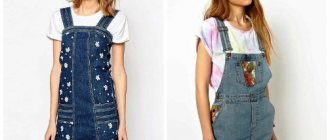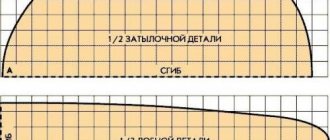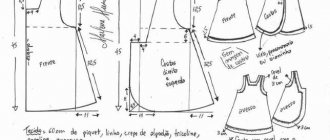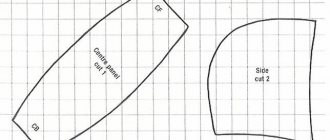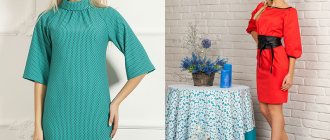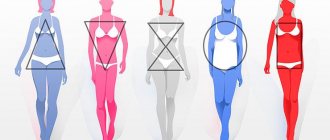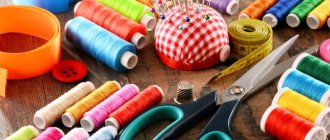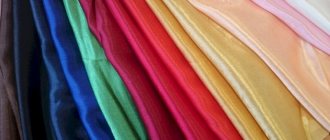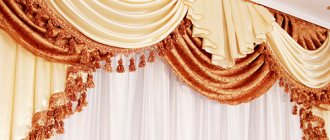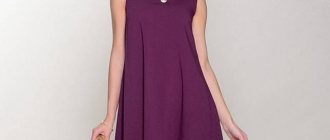How to choose high-quality corduroy for a sundress?
Previously, corduroy fabric was made only from cotton, without any impurities. Currently, you can still find natural material on the shelves of sewing stores, but experienced seamstresses do not recommend using it for sewing clothes.
Pure cotton corduroy has a rough texture and will be uncomfortable to wear. The edges of the finished product will require high-quality processing, since the natural material crumbles a lot.
Corduroy consisting of cotton and synthetics is suitable for sewing a sundress. This fabric is softer, does not fray and wrinkles less. It is important to know that the higher the percentage of synthetics in the material, the more it will become electrified and attract small particles and dust.
Therefore, corduroy consisting only of synthetics is not suitable for sewing clothes. It is better to give preference to a material that contains 45-60% cotton and 55%-40% synthetics.
What you need to pay attention to when buying corduroy fabric:
- In the store, corduroy should be stored in rolls. If the material has been lying folded in several layers for a long time, then the pile may fall out or change color at the bends.
- Fabric containing cotton and synthetics should not be very shiny. If the fibers shine too much in the light, then this corduroy is made only of synthetics.
- The color of the material must be uniform, without dark or light spots.
Corduroy fabric has a stripe pattern. They are called scars. All scars should be even and parallel to each other.
This is interesting: Pattern Women's straight jeans (p W24-36 L30-36)
What type of corduroy is suitable for a summer, warm women's sundress?
Corduroy is divided into subtypes according to thickness, width of ribs and length of pile. In the table below you can see a brief description of the different fabrics. Knowing the characteristics of each type will help you choose the material for sewing a sundress for any season.
| Name | Characteristics | What time of year can you wear it? |
| Cord | Heavy and rough fabric. The width of the scars is from 5 mm. Contains cotton and wool. | Winter autumn |
| Velveton | Thin fabric. Absorbs moisture well, allows air to pass through and stretches. It has narrow scars, about 2-3 mm wide. | Late spring, summer |
| Microvelvet | Externally similar to corduroy, but less elastic. The tissue scars are very narrow, barely noticeable (1-1.5 mm). | Summer, early autumn |
| Luxury corduroy | Dense and warm material. The length of the pile is higher than standard, the scars are small. Keeps its shape well and does not stain. | Winter, late autumn, early spring |
| Sky corduroy | Smooth texture without pattern. Does not allow moisture to pass through and retains heat well. | Autumn, spring |
| Satin corduroy | Very short pile (0.2-0.5 mm), smooth surface. The fabric is thin and ventilates well. | Summer |
| Gloss | Elastic and thin material, without scars. Permeates air and absorbs moisture. Shines strongly in the sun. The composition contains a high content of synthetics; in some cases, the fabric consists only of artificial threads. | Summer, late spring. |
Experienced seamstresses advise beginners to pay attention to the width of the hems. Material with narrow stripes is always thinner and more elastic than corduroy with a large pattern.
Trapeze sundress
A sundress with a laconic cut in the shape of a trapezoid is a successful basic item both in the summer wardrobe and in the cold season. The wide hem hides the tummy, wide hips, imperfect waist, and emphasizes slender legs
A simple top is equally suitable for owners of neat breasts and a full bust, focusing attention on beautiful shoulders and arms
A trapeze sundress can be with or without sleeves, with patch and secret pockets, with a varied neck shape, with embroidery, lace, flounces on the hem and other decor. It’s so easy to sew any model that even someone who has never attended a cutting and sewing course, or cut anything other than a chintz apron in a technology lesson at school, can do it.
Absolutely any color is suitable, but it is better to give preference to plain fabrics. The style is interesting in itself, and does not require additional measures to attract attention, so fabric with a pattern may look tacky.
You can cut out a sundress directly on the fabric, using, for example, thick knitwear with a stretch effect as a basis:
- With a width of 1.5 meters, you will need only 1 meter of length, since the style assumes a short length.
- First, you need to fold the fabric in half twice with the wrong side up (the pattern will be cut out on it) to get a rectangle with sides of 100 and 37.5 centimeters. Then, using chalk and a ruler, the construction of the pattern begins.
- The first thing to draw is the neck. The depth and shape can be any; the classic version is a narrow round neckline 4 cm deep and approximately 8 cm wide.
- Next, from the top point of the neckline, the height of the armhole is laid down, equal to half the girth of the armpit. Through the bottom point of the resulting segment, from the right edge, a line equal to one-fourth of the volume of the chest is measured.
- If the model is planned without sleeves, 5-10 centimeters are measured from the neckline height point to the left for the shoulder seam. The extreme point of the segment is connected by a smooth line to the extreme point of the OG - these will be the armholes.
- Then the length of the product is set aside. It can be made as large as the fabric supply allows. The average length is approximately 80-90 cm. The corners are smoothly rounded, forming a hem line with a margin for hem.
- The last step of pattern construction is to draw one diagonal line from the extreme point of the hem to the bottom edge of the armhole under the arm. The drawing is ready and can be cut out. It turns out two parts, one of which is the front part, and the second is the back. The neck of the front part can be made a little deeper.
- Further actions are predictable and simple: sweep away two parts, try on the item, adjust if necessary and start stitching on the machine. All internal seams are finished with overlock. The hem is made as narrow as possible, so the product looks neater.
How to sew a trapeze sundress in just an hour is in the next video.
A trapeze sundress can be worn as an independent element of the wardrobe, or can be incorporated into sets over blouses, shirts, items with long sleeves and a high neck.
Denim sundress for girls: sewing recommendations
We will take the basis of the pattern for the denim sundress from the T-shirt. Determine the length of the straps and the sundress yourself before you start cutting. Try on the patterns to see if jeans alone are enough for you: it all depends on the length of the sundress.
If you decide to sew a sundress for a girl taller than 116 cm, then jeans alone will not be enough for you.
Don't forget about seam allowances - 1.5 cm. Denim fabric is very loose, so make larger allowances. Finish the edges of the seam allowances using an overlocker or zigzag. Use special denim needles or size 90 needles.
So, let's sew a denim sundress!
Pattern construction and cutting
- old jeans;
- album sheet;
- T-shirt;
- tailor chalk, pencil;
- ruler;
- 2 buttons, 2 fasteners;
- needles-pins;
- threads
- part 1 - facing of the top of the product;
- part 2 - middle of front and back;
- detail 3 - side part of the sundress.
Lay out the T-shirt on a landscape sheet. Fold the T-shirt in half, then fold the top of the T-shirt in half.
Trace the armhole lines with a pencil, mark the lines of the middle and top seam. Add 2 cm along the chest line.
We divide the pattern into three parts:
Uncover the following number of parts:
- side part of the product - 4 pcs;
- middle front and back - 2 pcs;
- facing of the top of the product - 2 pcs;
- pocket 1 piece;
- straps - 2 pcs.
Lay your jeans out on a flat surface. To begin with, we cut out part 2 - 4 pieces. Don't forget the seam allowances!
Then we cut out the middle of the front and back. There is only half of the detail on the pattern. You need to fold the fabric along the floors and cut out the part.
We cut the facing of the top. The top facing pattern is also only half. You need to fold the fabric in half.
Work the edge of the pocket first. The edge can be processed with a double needle and multi-colored threads.
Then sew it to the middle of the front.
Sew the side parts to the middle front. The seams can also be finished with a double needle. We do the same with the back. We sew 2 straps.
We sew the facings of the top of the product together.
We sew the back and front of the product together. We pin the straps with needles to the top of the front, closer to the middle.
Apply the right side of the top facing to the right side of the product. Make sure the side seams match. Sew the details. Finish seams and press.
Sew the side seams of the facing and the product itself together so that the facing does not ride up and get in the way.
Hem the bottom of the sundress.
Sew snaps (buttons) to the sundress, fasteners to the straps.
The denim sundress is ready!
Double-sided sundress
For this model, two bright materials are combined or one of the sides is made of plain fabric.
Using, for example, thin jeans looks very stylish. To sew a sundress for a girl with our own hands we will need:
- fabric - two pieces of fabric, 0.8 m each;
- threads to match the color of the fabric;
- sewing tool.
How to sew
We start by making a life-size pattern.
One cell in the drawing corresponds to a square with a side of 1 cm.
The patterns are made for three sizes:
- from 1.5 years to 2 years (= height 86 – 92 cm);
- from 3 years to 4 years (= height 98 – 104 cm);
- from 5 years to 6 years (= height 110 – 116 cm).
The patterns are drawn taking into account allowances of 1 cm.
We cut out the parts from the first and second fabric - according to both patterns. There will be 4 blanks in total.
If we sew a sundress with pockets or appliqué, then we cut out blanks for them.
We process the edges of all workpieces around the perimeter using an overlock stitch or a zigzag stitch. Sew a pocket or applique (if provided) onto the front side of the front front.
We fold the blanks from the first fabric with the right sides and sew them together. Press the side seams.
We proceed similarly with blanks from the second fabric.
After you have sewn both parts of the sundress and pressed the seams, you can begin assembling.
Place one dress into the other with right sides facing each other and align along the cuts at the armholes and rollout.
Then we sew the seams along the armholes, straps and rollout. On the roll-out and armhole allowances, we make notches in several places so that the fabric does not pull when turning out. At the ends of the straps we cut off the allowances a little.
We turn the product right side out, sew the edge and iron it. We perform decorative stitching with a slight indentation from the edge along the line of the armholes, straps and roll-out. Hem the bottom edge.
That's it, the sundress is ready!
Current colors
Women's corduroy sundresses came into fashion back in the 70s, and remain stylish today. Only the styles and shades change. The table below describes the fabric colors that will be trendy this year.
| Color or shade | What time of year can you wear it? |
| Pink, peach, coral | The beginning of spring |
| Blue, mint, azure | End of spring |
| Raspberry, lime, pastel orange | Early summer |
| Bright red, yellow, lavender | End of summer |
| Burgundy, purple, brown | Beginning of autumn |
| Blue, gray, copper | Late autumn |
| Cobalt blue, walnut, gold | Early winter |
| Dark grey, black, light brown | End of winter |
A material containing a high percentage of synthetics will shine more, this is important to consider when purchasing fabric with metallic shades. Golden or silver corduroy gloss is suitable for concert and evening wear. A sundress made from such fabric for everyday wear will attract too much attention.
Fashionable styles
Corduroy sundresses are suitable for all women, the main thing is to choose the right style according to your figure. Slender girls should pay attention to fitted and tight-fitting models. You can choose any fabric for sewing. Thick and thin corduroy emphasizes all curves equally well.
For women with curvy figures and slight figure flaws, it is better to give preference to products made from coarse material. It is not recommended to choose models with thin straps and high waists. These styles will make your arms look thicker, and the high waist will “enlarge” your protruding belly. Straight-cut sundresses and a shirt style will hide imperfections and help shift attention from the belly to the chest.
On young girls from 16 to 25 years old, models with an asymmetrical hem or wrap, as well as short sundresses with a full skirt and many folds, will look good.
For women aged 50 years and over, products with buttons, wide straps, and without large pockets are suitable. The fabric should be dense and contain a small amount of synthetics. It is not recommended to wear models that are too open. Pregnant girls need sundresses that do not restrict movement. A-line and high-waisted models look good on a round belly and also do not put pressure on it.
This is interesting: Pattern Women's denim sundress (p 6-20 UK)
New look style for 8-10 years
Any girl will love this charming children's sundress with a fluffy skirt and bow. Sewing will not take much time: its complexity is minimized. First you need to measure the circumference of the hips, the distance to the waistline and the estimated length of the model. A gathering allowance is added to the hip measurement to make the bodice and skirt appear fuller.
Sewing the model is like this:
Having cut out two rectangles, taking into account the allowances, they are ground down on the sides and the edges are overcast. The top edge is folded over to form a drawstring, after which two loops are made in front for threading a bow. In order for them to be reliable and not tear the fabric, in the place where they are made it is necessary to reinforce the fabric with an adhesive pad
It is important to note that the width of the drawstring should cover the loops.
- The drawstring at the waist is secured with two lines: along the top and bottom edges. It is advisable to select threads for stitching to match the tone of the fabric, so the product will look neater. When making stitches, it is better to focus on the marks to the right of the presser foot, located on the metal plate of the machine. This will make the lines even and parallel. If you don’t want to bother with the drawstrings, you need to iron their allowances. This will allow you to lay the lines evenly and without preliminary basting. To prevent the stitching line from moving, it will be enough to secure it in several places with sewing pins.
- Having outlined the waist line (you can attach the product to the figure with the wrong side), sew on the drawstring, leaving room for threading the elastic bands (the width of the sewing seam is 0.1 cm). The drawstring around the waist should be solid, including going over the side seams. Having divided the width of the part into three parts, lay two more lines for the elastic bands, also leaving a small gap for threading.
- Having measured out the elastic bands of the required size, they are threaded and connected into rings. The gathers at the waist are distributed evenly.
The model is convenient because it allows you to change the width of the top to make putting it on easier. This sundress looks stylish and beautiful.
Taking measurements
A women's corduroy sundress requires care when creating a pattern and taking measurements, especially if the chosen type of corduroy does not stretch.
First you need to measure your chest circumference (CH). A measuring tape is placed under the shoulder blades and along the highest point in front. Waist circumference (WC) is measured by wrapping a tape around the abdomen 2 cm above the navel. The next measurement is hip volume (HC). The tape should be placed where the buttocks protrude the most.
To correctly create a pattern, you need to measure the length to the waist of the front and back. These are 2 different quantities and are measured separately. To find out the distance to the waist in front (Dtp), the end of the tape should be applied to the base of the neck, stretch the tape through the highest point of the chest and stop at the waist line. To make it more comfortable, you need to tie a clothesline around your stomach. This line will indicate the waist.
The length of the product to the waist from the back (Dts) must be measured by laying a tape from the base of the neck along the spine to the waist line.
For a sundress that will be tailored to fit your body, it is important to correctly measure your chest height (CH). The tape is laid from the base of the neck to the most protruding point. Inexperienced seamstresses often make the mistake of angling the tape towards the nipple. The line must be strictly vertical.
The last value that needs to be recorded is the length of the product (DI). From the back, from the base of the neck, you need to stretch the tape down the spine, to the legs, to the desired length. There is no need to press the tape to your back; the tension should be weak.
Children's sundress with “wings”
It won’t take much time to sew a summer sundress for a girl that has lace wings sewn on instead of straps.
You will need:
- Some cotton fabric
- Lace “Sewing” - about 50 cm
- Rubber
To sew a sundress you need:
- Measure the length of the sundress and cut out 2 parts (front and back). Don't forget about seam allowances, drawstring and hem finishing.
- Place the shelves right sides inward and sew the side seams.
- Sew lace to the front and back flaps as shown in the diagram above.
- Finish the edges of the armhole with a hem stitch. Topstitch.
- Fold the edge of the neck so that the elastic can be inserted inside. If the width of the lace does not allow this, sew an additional narrow satin ribbon or bias tape on the wrong side. Insert the rubber band.
- Finish the bottom edge of the sundress. You can sew a wide ruffle or lace along the bottom of the sundress.
Another summer outfit is ready!
The result is a light summer dress with lace wings. It looks very romantic. Additionally, the sundress can be decorated with bows made from braid and ribbons.
Making a pattern and sewing a corduroy women's sundress with your own hands. Step by step description
The patterns for all styles presented later in the article are based on basic drawings of different dress models. In accordance with the model, you need to modify the pattern; in some cases, you will need to take several additional measurements.
Models with straps
A women's corduroy sundress can have thin or wide straps. The straps can be made straight or crossed on the back. For such models, you should take as a basis the basic dress pattern without a bust dart, only the front part of the drawing.
Women's corduroy sundress with straps, pattern.
How to change a pattern:
- The armhole needs to be made deeper by 8 cm.
- Enlarge the neckline too. The cutout at the back should be 3-4 cm smaller than at the front.
- Mark the straps. You need to make them shorter in front, and 2 times longer in the back.
- To prevent the bottom of the product from being too narrow, you need to make a cut on the side. From the bottom edge of the product, on the side, you need to cut 12-15 cm up.
How to sew a sundress:
- The front and back parts need to be sewn along the side seam up to the cuts.
- Iron seam allowances from the inside out and stitch.
- Fold and iron the seams at the back and front of the neckline and stitch.
- Finish the edges of the straps and sew them to the sundress.
- Hem the hem.
Such simple models can be complemented with 1 or 2 wide pockets. The size and depth are selected individually.
Buttoned models
To sew a sundress with buttons on the front, you need to take as a basis the basic pattern of a straight-cut dress or a classic fitted model. The drawing will not have to be changed too much. You just need to divide the front part of the pattern lengthwise into 2 equal halves and make allowances of 3-4 cm to fold the fabric at the edges. You can also adjust the armhole and remove the sleeves, add wide straps (5-6 cm).
How to sew a sundress with buttons:
- Sew the back and both halves of the front along the side seams.
- On the left side, step back 3 cm from the cut and make cuts for buttons. Process them using an overlocker. Fold the cut, iron and stitch.
- On the right, fold 3 cm on the cut on the right side of the front. Sew buttons.
- Process the bottom and neck of the dress from the front and back.
- Sew on the straps.
If the pattern of a fitted dress was taken as a basis, then several slots for a belt can be made on the belt.
Summer options
A women's corduroy sundress, intended for summer, can be sewn using an A-shaped silhouette pattern, then no changes in the construction of the drawing are needed. If you plan to make a model with a belt and a high waist, then you need to take into account the number and width of the pleats on the skirt. You can sew a summer sundress with an open back from thin corduroy. The pattern consists of 7 parts. The straps should be wide and trapezoidal.
Creation:
- Measure the width of the chest from the side seam to the solar plexus. Draw a trapezoid, the bottom of which will correspond to this value, and the top should be 2-3 times narrower. The length of the strap of this style corresponds to the height of the chest + half-circumference of the neck.
- Cut out 4 identical pieces and stitch 2 at a time, with the wrong sides facing each other.
- Cut out a belt as long as OT, 12 cm wide. Fold in half and stitch along.
- For the skirt you need to draw a rectangle with sides DI*(OB+10 cm). Make 4 folds at the front, each 2.5 cm wide.
- Collect all the parts. The seam on the skirt should be at the back, just like on the waistband.
The straps can be tied around the neck, but it is better to buy special fasteners and sew them to the narrow edges of the straps.
Warm options
To sew a winter sundress, you will need dense fabric with high pile. The patterns can be taken the same as for the model with buttons or straps. The most popular option for a warm product is a straight silhouette. To sew, you will need to take a pattern of a basic straight dress, mark the place for the darts on the chest, remove the sleeves and slightly enlarge the armholes.
How to assemble such a product:
- Fold and iron the seams at the neckline and armholes and stitch.
- Sew the halves of the product along the sides.
- Fold and stitch the bottom of the sundress.
For convenience, you can make 1 or 2 side cuts of 10-15 cm each.
Floor length
It is better to sew a maxi-length sundress from thin corduroy. You can use any basic dress pattern as a basis. You will only need to change the shape of the sleeves and the length of the product. To make a long sundress comfortable to wear, you need to make side slits. If they are located on both sides, then their length should be knee-length. If only one incision is planned, then it should be extended another 7-12 cm upward.
Wrap style
The top of such styles is modeled according to the basic pattern of the base dress. The front part of the pattern is changed, dividing it into 2 parts at an angle. It is necessary to add seam allowances of 3-4 cm. For the skirt pattern, a drawing of the lower part of a fitted dress is suitable.
How to assemble the product:
- At the bottom, assemble on the front parts of the top.
- Sew side seams and shoulders together.
- Process the neck.
- Make a wrap at the front by placing a wide piece on top of a narrow one.
- Sew the bottom details on the sides.
- Finish the bottom of the hem.
- Baste the top and bottom parts and stitch.
- Finish sleeve armholes.
It is important not to forget to make folds along the waistline on the top of the sundress and on top of the skirt, otherwise the corduroy will stick out unsightly in these places.
Double-sided children's sundress
At first glance, it may seem that sewing a double-sided sundress is much more difficult than a regular sundress, but this is not so. The speed and ease of sewing is its main advantage. And the original straps with knots and the contrast between the front and back sides make the sundress very unusual.
You will need:
- Two pieces of spectacular fabrics, 80cm each. One side can be made from thin jeans (dark blue or light blue). The color of the jeans goes beautifully with the multi-colored cotton.
- Sewing threads that are harmonious in color.
The pattern for a double-sided sundress is available in three sizes:
- 86/92 (1.5-2 years)
- 98/104 (3-4 years)
- 110/116 (5-6 years)
Seam allowances of 1 cm are taken into account.
Pattern for a double-sided children's sundress
To sew a double-sided sundress you need:
- Transfer the pattern to paper (1 square = 1 cm) and cut out the parts.
- Cut out the front and back parts of the sundress from fabric A and fabric B. You will get 4 pieces in total. Also cut out pocket pieces if needed. (Let me remind you: seam allowances of 1 cm are taken into account.)
- Finish all edges and hems of the dress with a zigzag stitch or overlock stitch.
- Sew a pocket or applique onto the front piece of Fabric A (optional).
- Place the front and back pieces of Fabric A together, right sides together. Stitch and press the side seams.
- Place the front and back pieces of Fabric B together, right sides together. Stitch and press the side seams.
- Place one dress inside the other, so that they are right sides together, and sew the dresses together along the armhole, straps and neckline.
- Notch the seam allowances several times at the neckline and armhole. The allowances at the ends of the straps can be cut off a little.
- Turn the resulting double dress right side out and iron all edges.
- Use a straight or decorative stitch along the armhole, straps and neckline, not too close to the hem.
- Hem the hem of each sundress. You can sew cotton lace, decorative ribbon or braid onto one side of the sundress.
Hooray! The sundress for my daughter is READY!
I really hope that the presented models will soon appear on your girls. Send a photo! For those who are just thinking about learning how to quickly sew simple and cute things for their children, I highly recommend getting acquainted with
don't forget to look:
- How to sew a fleece hat for a girl and a boy
- How to sew a skirt for a girl
- Frying pan for fun pancakes
Selecting a pattern
The choice of pattern mainly depends on the desired style and ease of sewing. This is often influenced by fashion trends, an important place among which is occupied by women's sundresses and loose denim dresses.
A pattern is a rough sketch on paper or tracing paper of the future dress with a specific drawing of seams, pockets and details. Patterns often help not to get confused in what order the work should be done, where the places for sewing the seams are.
After you draw the pattern, you need to transfer its main elements to the fabric. This can be done either with a regular pencil or using special sewing tools.
What to wear with, how to combine?
A corduroy sundress does not harmonize with open shoes, so it is better to give preference to ankle boots, boots and closed shoes. In cool weather, you can wear nylon tights or plain leggings underneath.
Under a sundress with wide straps, you can wear a turtleneck, a long-sleeved shirt or a pullover in a contrasting shade. For layering, fashion designers also advise wearing a denim jacket. In summer, the strappy style is worn with a light T-shirt underneath and without tights.
Warm models with closed shoulders go well with a thin chiffon scarf around the neck. As a headdress, you can take a felt hat with a wide, wavy brim. It’s easy to sew a women’s sundress from corduroy yourself.
The main thing is to choose the type of fabric and style that matches your figure and age. They are easy to care for, and since corduroy will not go out of fashion for a long time, a sundress can last more than 4 seasons.
How to sew a model with a flounce on the shoulders?
Over the past few seasons, off-the-shoulder clothing has not gone out of fashion. To get into the trend, it’s enough to complicate the pattern of your summer sundress a little, and sew the product with a beautiful flounce on the shoulders.
For this you will need:
- textile;
- threads to match;
- chalk;
- safety pins;
- scissors;
- tape measure;
- notepad and pen;
- elastic band from 1 to 1.5 cm wide.
The work is carried out in stages:
The first stage involves taking measurements. For a simple dress, you traditionally need to find out the half-circumference of the chest, waist and hips. If the dress is not fitted, it is enough to measure the chest and hips. If the chest is very full, when cutting the fabric, take into account the extra centimeters for darts.
The parts of the flounce are sewn together at the side seams, then you need to connect the middle of the base dress and the middle of the flounce so that the same amount of fabric protrudes at the edges. You should end up with a T-shaped dress with some extra fabric allowance on top. Next, pin the two parts together and sew the flounce to the base from armhole to armhole on both sides.
Now it’s time to hem the top of the sundress with a closed hem seam, leaving a small area through which the elastic will be threaded. The width of the seam should be slightly larger than the width of the elastic, the length of the elastic should be equal to or slightly less than the circumference of the shoulders.
To thread the elastic, it will be convenient to fasten a pin to one end of it, insert it into the unstitched end and, gathering the fabric, stretch it around the entire circle to the next hole in the seam. The ends of the elastic can be basted to make it easier to stitch on a machine, and the pin can be removed.
When the top of the dress is ready, all that remains is to hem the hem and the lower edge of the flounce with a hem seam and finish them with an overlocker. Lastly, the belt is sewn, and the sundress with a flounce on the shoulders is ready.
This model is suitable for girls with absolutely any figure. It can be modified with a belt and accessories, and made into your favorite outfit for a walk or a romantic date.
A sundress with flounces can also be made from knitted fabric. The results are very interesting and unusual models that are perfect for both a walk and an evening out. The following video will show you how to do this:
Taking measurements for women and girls
Before the denim sundress pattern is made, you will need to obtain the required dimensions. The following quantities will be required:
- To get your chest circumference, you need to measure the widest line of your chest. Since the girth will change slightly during breathing, it is necessary to take a length at which the centimeter will not interfere with breathing, but it should not be too loose.
- To obtain the waist circumference, measure the narrowest area. In this case, it is not recommended to tighten the centimeter too much.
- Hip circumference is obtained by measuring the widest part of the circumference. Usually they retreat 18-22 centimeters below the waist line.
Denim sundress
After the measurements are taken, you can start choosing a pattern.
Required tools and materials
A hand-sewn dress is the result of a labor-intensive process. In order to do everything correctly, you need to prepare the following:
- Needles of several types.
- Thick and thin threads.
- You will need an elastic band or thread that stretches.
- Chalk.
- Pins.
- Awl.
- Thimble.
- Tracing paper and pencil for patterns.
- Scissors.
During the work, it is necessary to take into account that denim is a dense material. Therefore, when working with it you will need thick and sharp needles. It is also necessary to use threads of suitable thickness, otherwise the seams will be fragile.
Sundress with lace top
Important! When sewing jeans, you need to decide whether to do it on a machine or sew the fabric by hand. It is more convenient to do the first method, but you must have the appropriate work skills. When working by hand, the sewing process will be labor-intensive, but in this case the seams will be more neat.
This option is more suitable for beginners.
Choosing a style and fabric for a sundress
First of all, let's decide on the material.
We sew from new denim or from used denim items.
The second method is more convenient, since a children's sundress will turn out even if there is no pattern.
The easiest way to sew sundresses with straps, as well as one-piece models.
Advantages of a sundress:
- Low fabric consumption means low costs.
- Variety of options in possible finishes.
- The ability to combine different materials in one model.
- The sundress can be combined with different blouses, T-shirts and so on.
Advice! A comfortable skirt model, complemented by belt straps, is already a sundress.
Sewing the product
After you sew the top of the product, you need to think about the style of the skirt. We will cut the skirt directly from the trouser legs. We cut off the top of the jeans, and we get two unique pipes made of fabric. Each pant leg must be cut along the outer seam. There are two pieces of fabric left, with a seam running down the middle - this will become the basis for the skirt.
Flared
A sundress for a girl or young girl is best made with a flared skirt; it will look playful, airy and romantic. For a sundress skirt that is not too flared, you will simply need to sew two pieces of denim fabric together, strictly along the remaining seams. Before starting work, be sure to accurately measure the length and width of the future skirt. Make sure that you can easily put on the product; if necessary, you can insert a zipper. Buttons will be an excellent fashionable alternative; they don’t have to be used as decoration; if you make a robe skirt, it can easily be fastened with them.
Straight
Creating a straight-cut skirt for a denim sundress is not much different from the technology with a flared style. You will need to measure the width of the hips, cut the pieces of fabric so that they are equal in width along the entire length.
To add elegance to the sundress, leave a small slit at the hem, but note that the fabric should be carefully trimmed on both sides to make it look neat. The same goes for the bottom hem, as well as any hems or frills. After you cut and sew the top and create the bottom of the sundress, they need to be sewn together, leaving a seam on the inside.
Sewing a sundress yourself is not at all difficult, and at the end you can start decorating, a woman’s favorite pastime. In the coming season, inserts made of various materials or decorations made of rhinestones, beads or artificial pearls are very popular.
General recommendations
Sometimes the presence of a pattern is an obstacle to sewing. In fact, patterns make the work much easier. Unfortunately, it is impossible to find ideal patterns for children, since children are individual and grow quickly. But creating the desired pattern in a minimum of time is a completely feasible task. Moreover, often a “homemade” pattern fits better than the one offered in needlework magazines.
To make your work easier, you need to adopt a few simple tips:
- the pattern does not include seam allowances: they are added during cutting;
- so that there are no overlaps of material when assembling the product, notches are made when cutting: an allowance of 0.5 cm is notched at the level of the waist, hips and hem, folding the side sections of the back and front together, aligning their edges;
- simple products without a tight fit can be “swept” using a machine stitch “wide step” of 4 mm;
- if you have a standard pattern for the desired age, you can cut out a sundress using it and then fit it to your figure;
- It is not recommended to make a sundress with a tight fit: the skin should “breathe”;
- It is better to choose natural textiles, ones that do not slip;
- It is not advisable to sew a model for a girl from bi-elastic fabric (stretching lengthwise and crosswise): such textiles require special production equipment;
- We must not forget about WTO: skipping ironing of processing units always affects the sewing time and the final result;
- if the work uses an elastic band (linen, elastic thread), ironing it is unacceptable, as this will cause it to stretch;
- for perfect alignment of seams you need to use sewing pins;
- if the seam turns out to be an accordion, it will not be ironed, such a defect must be redone immediately;
- To sew the bottom evenly, you can first iron the seam allowance: this will prevent the fabric from twisting.
Besides:
- The work can be made easier if you use a comfortable T-shirt as a pattern for a girl. This will reduce cutting time and eliminate the need to create a pattern. In some cases, you can make a pattern directly on the fabric, taking into account the circumference of the hips, chest and length of the product.
- If you need to make changes when trying on, you can try on the future sundress on the wrong side. This method is good if the cut is symmetrical. It allows you to better see imperfections in the fit.
- In order not to buy extra fabric, you can first prepare a template, then make an approximate layout of the patterns, taking into account the width of the material you like. It is worth adding about 5 cm to the approximate layout.
- Another little trick: to make the sundress look like it came from a store, the width of the finishing seams of the parts must be identical. In addition, it is worth considering the secret of the professionals: if the print allows, it should be symmetrical, matching the side seams (stripe, check).
Uncover
Next we will show you how to make a pattern for an office-style sundress. To do this, first take measurements:
- circumference of the waist, chest, neck, hips;
- back width;
- back and front length from top to waist;
- shoulder width;
- breast dart solution;
- chest height.
This model is cut almost the same as a summer sundress. The difference between them is expressed in the fabric allowance required for a loose fit. For the office version, 2 centimeters are set aside here, for the summer version - half as much.
Sundress with lace
As a basis for cutting, use a rectangle with sides of half the chest circumference and the length of the product. Levels corresponding to the waist, hips, chest and neck are carried out.
In the future, this diagram needs to be made more detailed. To do this, you need to follow these step-by-step steps:
- Along the horizontal line of the chest, you need to put half of the dart solution on one side of the rectangle. On the other hand, half the length of the back.
- From the obtained points it is necessary to draw vertical lines upward.
- In the upper corner, a quarter of the neck circumference is laid horizontally from the edge. On the other side, draw a line of shoulders from the received marks with a slight slope.
- On the front panel, step back 3-5 centimeters from the dart opening mark, put a mark and draw a second dart line.
- It is necessary to extend the shoulder seam of the front flange. This is done at a distance equal to the tuck of the dart.
- Now we need to determine the size of the armhole zone. To do this, half the chest circumference is divided by 4. A segment of this size is set aside from the “1/2 back size” mark. After this, roundings are made to connect the shoulder seams. In this case, smooth curves reach the chest line.
- Draw a vertical line passing through the central point of the armhole area. It should reach the bottom border of the original rectangle.
- Now you need to measure the difference between the chest and waist circumferences. The difference should be distributed into the side seams, and darts should be used at the back and front.
- Now you need to draw the line of the hips. To do this, step back from the side of the rectangle by a quarter of their circumference and draw a rounded line.
Children's sundress with lace
Now the pattern with which you can start sewing a sundress is ready.
You may be interested in: Simple patterns of baby rompers for newborns
Sundress with flounce at the neck for 5-7 years
This model is very simple to implement. It will take no more than an hour to create. In order not to be tricky with the pattern, you can create a template based on the sample. The photo shows a pattern for a 5 year old girl (height 110 cm).
For those who find it difficult to figure out how to build a pattern, a short instruction will help:
- on a large sheet (newspaper or leftover wallpaper) draw a rectangle measuring 27.5 x 60 cm (half of the pattern with a fold);
- step back 15 cm from the middle of the top line and place point A;
- from the resulting point A, they retreat down about 15 cm and draw a perpendicular line connecting the two sides of the rectangle (this is the armhole line);
- then they decorate the side, as in the photo: 22.5 cm are retreated from the middle of the second line (armhole level) and point B is placed, then points A and B are connected;
- step back 3 - 3.5 cm from the bottom lateral line and place point C, then connect it to point B;
- the bottom line should be rounded: point C is smoothly connected to the middle of the bottom;
- The shelf's neckline is slightly larger, so the shelf's neckline should be 1 - 1.5 cm lower.
Sewing a sundress is simple:
- the product is placed on the wrong side, the armholes are folded and they are stitched with a seam into a hem with a closed edge;
- after the armholes, the side cuts are stitched down and processed using an overlocker;
- the bottom of the product is folded 2 cm, folded 0.7 cm and stitched on a typewriter;
- the sides of the flounce are ground down, overcast, and then the bottom is turned in and stitched with a hem seam with a closed edge;
- Having outlined 2 middles of the shuttlecock, 1 shelf, 1 back, they are combined with sewing pins (the shuttlecock rings the top with the front side on the face):
- The shuttlecock is stitched to the base.
- The upper side of the shuttlecock is folded to the width of the elastic, stitched on a machine, then the elastic is threaded (length approximately 45 - 49 cm).

